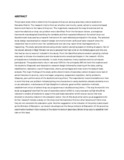| dc.description.abstract | This project study wills to determine the causes of drop out among secondary school students in
Naivasha District. The research tried to find out whether community, social, school or economic
based factors contribute to the issue of drop out. The magnitude, causes and the way forward as
well as recommendations on drop out problem were identified. From the literature review, a
conceptual framework was designed describing the variables and their expected effects on the
school drop out. Questionnaire was used as a research instrument for each selected participant in
the study. The selected study design was descriptive research design corrurionly known as Ex
post facto research since the researcher has no control over the variables and one can only report
what has happened or is happening.
The study sampled schools using simple random sampling based on folding of papers. Out of
the eleven schools in Gilgil Division ten were selected that had a tick on the folded papers and
the one that had an exe (x) was not included in the study. From the identified schools random
sampling method was used to choose nine teachers and nine students who would participate in
the research. All the principals were included automatically. In total ninety students, ninety
teachers and te,n principals participated. The questionnaire return rate was 100% for the
principals, 89% for both the teachers and the students. Diagnostic and descriptive research
design followed by cleaning of the data, coding, classification, tabulation, use of frequencies,
charts, percentages and mean were the basis of data analysis.
The major findings of the study as the determinants of secondary school drop out were lack of
school fees due to poverty, early marriages, pregnancy, suspension/expulsion, family problems
Idisputes, poor performance of the students among others. The respondents' recommendations on
how to curb this drop out problem included giving more bursaries to needy students, educate
students more on sex education, maintenance of high discipline in schools, good conflict
resolution methods, establishment of out of school drop out programmes or studies among thers.
v
The way forward for the study as suggested was that the cost of secondary school which to many
was seen as high should be reduced to enable all students to acquire the post basic education
which was an outcry that was directed to all policy makers in the education sector. Out of this
study what came up as suggestions for further research include a study on the drop outs
themselves to find out what becomes of them once they do not complete the education cycle.
Another suggestion is the inclusion of the policy makers such as the Minister of Education,
curriculum developers at the Kenya institute of Education (K.I.E) as well as examination bodies
in future study of the determinants of secondary School drop outs to establish their take on the
Issue. | en |

